
Maultaschen, lit. 'mouth bags' is a traditional German dish that originated in the region of Swabia. It consists of an outer-layer of pasta dough which encloses a filling traditionally consisting of minced meat, smoked meat, spinach, bread crumbs and onions and flavored with various herbs and spices. Maultaschen are similar to the Italian ravioli but are typically larger in size—each Maultasche being approximately 8–12 centimetres across. They are almost invariably square or rectangular in shape.

The Prince-Bishopric of Würzburg was an ecclesiastical principality of the Holy Roman Empire located in Lower Franconia west of the Prince-Bishopric of Bamberg. Würzburg had been a diocese since 743. As definitely established by the Concordat of 1448, bishops in Germany were chosen by the canons of the cathedral chapter and their election was later confirmed by the pope. Following a common practice in Germany, the prince-bishops of Würzburg were frequently elected to other ecclesiastical principalities as well. The last few prince-bishops resided at the Würzburg Residence, which is one of the grandest baroque palaces in Europe.

Maulbronn Monastery is a former Cistercian abbey and ecclesiastical state in the Holy Roman Empire located at Maulbronn, Baden-Württemberg. The monastery complex, one of the best-preserved in Europe, was named a UNESCO World Heritage Site in 1993.
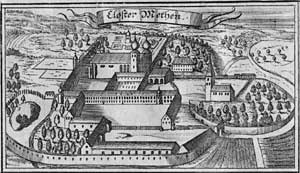
Metten Abbey, or St. Michael's Abbey at Metten is a house of the Benedictine Order in Metten near Deggendorf, situated between the fringes of the Bavarian Forest and the valley of the Danube, in Bavaria in Germany.
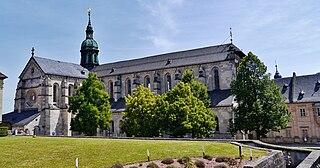
Ebrach Abbey is a former Cistercian monastery in Ebrach in Oberfranken, Bavaria, Germany, now used as a young offenders' institution.

The Abbey of Saint Victor, Paris, also known as Royal Abbey and School of Saint Victor, was an abbey near Paris, France. Its origins are connected to the decision of William of Champeaux, the Archdeacon of Paris, to retire to a small hermitage near Paris in 1108. He took on the life, vocation and observances of the Canons Regular, and his new community followed the Augustinian Rule.
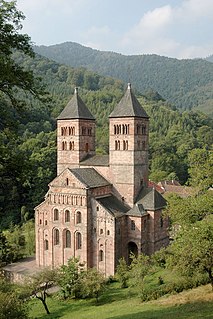
Murbach Abbey was a famous Benedictine monastery in Murbach, southern Alsace, in a valley at the foot of the Grand Ballon in the Vosges.

Schöntal Abbey is a former Cistercian abbey in Schöntal in the district of Hohenlohe, Baden-Württemberg, Germany. It is famous as one of the most impressive pieces of Baroque architecture in northern Württemberg and is now used by the Diocese of Rottenburg-Stuttgart as a retreat and training centre.
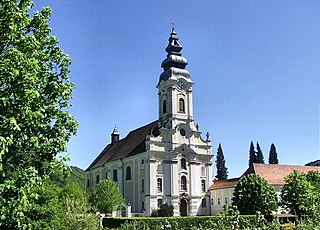
Engelszell Abbey is a Trappist monastery, the only one in Austria. It is located near Engelhartszell an der Donau in the Innviertel in Upper Austria.

St. Marienthal Abbey is a Cistercian nunnery in Saxon Upper Lusatia. The abbey is the oldest nunnery of the Cistercian Order in Germany to have maintained unbroken occupation of its house since its foundation.
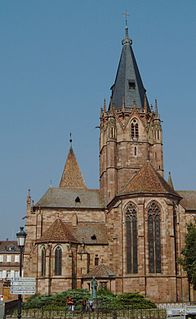
Weissemburg Abbey, also Wissembourg Abbey, is a former Benedictine abbey in Wissembourg in Alsace, France.

The Willibaldsburg is a spur castle, built around the year 1353, in Eichstätt in Upper Bavaria. Until the middle of the 18th century it was the representative castle and seat of Eichstätt's prince-bishops.

Hamborn Abbey is a Premonstratensian monastery in the Alt-Hamborn district of Duisburg, Germany. The abbey is physically located in the diocese of Essen, although not formally part of it.

The Altenberger Dom is the former abbey church of Altenberg Abbey which was built from 1259 in Gothic style by Cistercians. Listed as a cultural heritage, it is located in Altenberg, now part of Odenthal in the Rheinisch-Bergischer Kreis, North Rhine-Westphalia, Germany. Until 1511, the church was the burial site of counts and dukes of Berg and the dukes of Jülich-Berg.

Agnes of Rheinfelden was the daughter of Rudolf of Rheinfelden, and the wife of Berthold II of Zähringen, Duke of Swabia.

Walter von Lomersheim was a German knight considered to be the founder of Maulbronn Monastery.

Marienstatt Abbey is a Cistercian monastery and a pilgrimage site in Streithausen, Westerwaldkreis, Rhineland-Palatinate, in the Nister valley near Hachenburg.
Martin was the abbot of the Cistercian monastery of Pairis in Alsace, then part of the German kingdom in the Holy Roman Empire. Martin played a supporting role on the Fourth Crusade. He was a major source for the Historia Constantinopolitana, a history of the Fourth Crusade written by the monk Gunther of Pairis. Gunther's Historia serves as both a eulogy on the life of Martin and also an account of the translation of relics Martin brought to Pairis from the crusade. Gunther describes Martin as pleasant-looking, affable, eloquent, humble and wise.

Oelenberg Abbey is a Trappist monastery located in Reiningue near Mulhouse, France. It has been an important place of worship in Alsace since the 11th century but now hosts a small community of five monks.


















